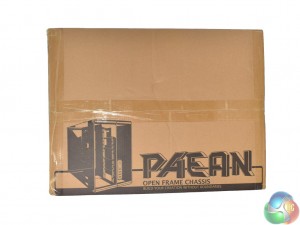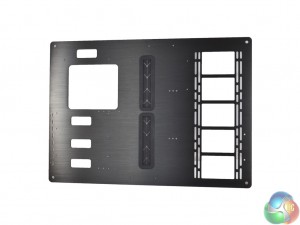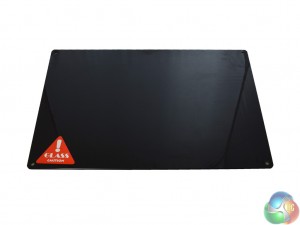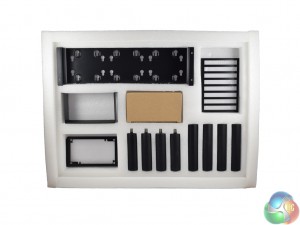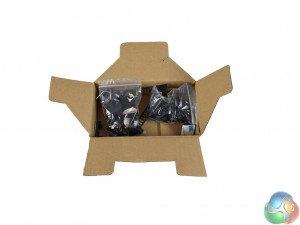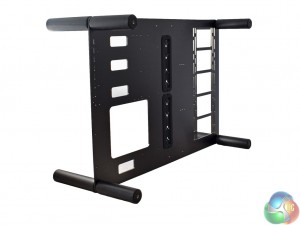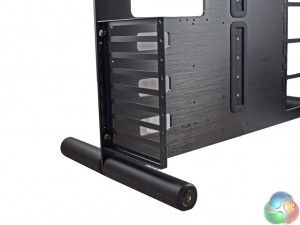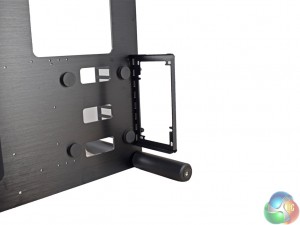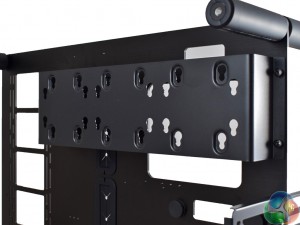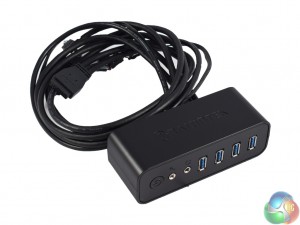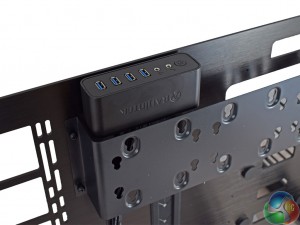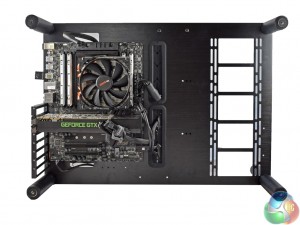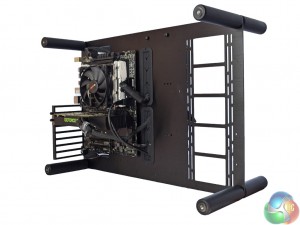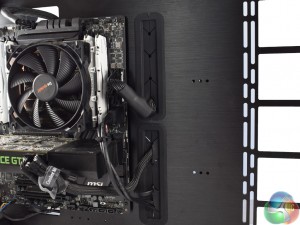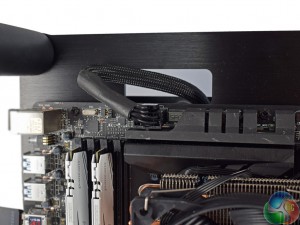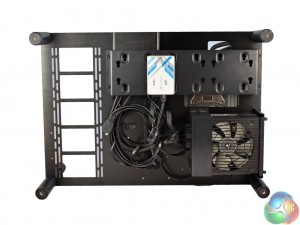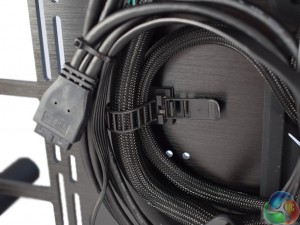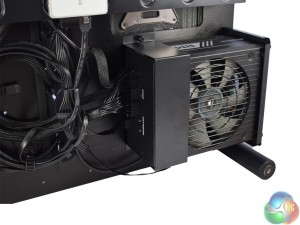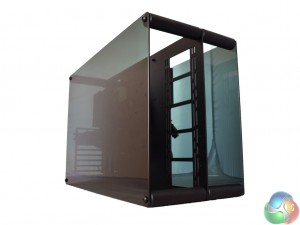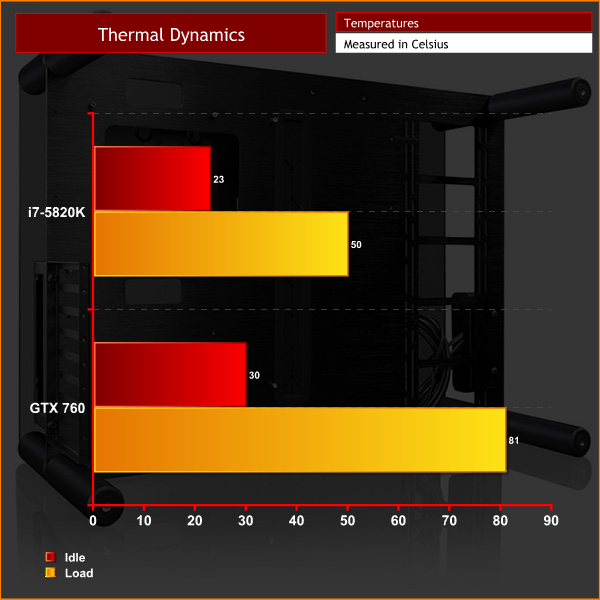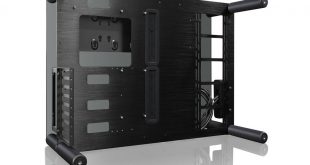
The Raijintek Paean is a case/test bench aimed at the enthusiast watercooling market. I say ‘case/test bench' as it is a halfway house between the two – it can be laid horizontally, allowing easy access to the motherboard, or vertically, as with a traditional chassis. Either way, the Paean is an open frame chassis as it makes use of just two side panels, meaning the front, back and top of the case is open to the elements. In this way, it is reminiscent of the ThermalTake Core P5.
Whatever type of chassis it may be, the Raijintek Paean is definitely a looker, thanks to its aluminium construction and tempered glass side panels. It does come at a cost, though – £149.99 here in the UK. Whether or not it is worth the money is something we will investigate in this review, as we look at build quality, practicality and cooling performance before giving a final verdict.
Specification
- Colour: BLACK Hair-silk anodized
- Internal Colour: Matte Black
- Dimension chassis body (D/W/H): 586*286*417mm
- Carton Dimension: 655* 485*150 mm
- Body Weight (N.W.): 14 KG
- Body Weight (G.W.): 16.5 KG
- Material: Aluminium 4.0mm + SGCC 1.0mm
- M/B Type: ATX/MICRO ATX/MINI ITX
- Graphic Card Support: Yes
- Power Supply: PS-2
- Power Supply Integration: Internal Bottom PSU (vertical), DVD Device, Slim DVD *1
- 3.5″ Device: 3
- 2.5″ Device (option/removable): 3
- I/O Panel: USB3.0 *4
- Hot Swappable: n/a
- PCI Slot: 8
- PCI Slot Tool-free: Yes
- ODD & HDD Tool-free: Yes
- Graphic Card Length: 310mm
- Side Panel Style: 5.0mm Tempered Glass
- Cable Management: Regular
- Front Cooling Fan: 120mm*2G120mm*3 ; 140mm*2 fan or 240/280/360mm radiator
The Raijintek Paean ships in a plain brown box, with just a small image on the front.
Upon opening the box, it is becomes clear (if it was not already) that the Paean is a bit different. This is because it comes completely disassembled, so obviously you have to put it together to get something resembling a computer chassis.
The first thing to come out of the box is the aluminium frame. It is is a large slab of brushed metal, with plenty of space to mount radiators (up to 360mm), motherboards up to ATX, as well as multiple graphics cards.
Packed underneath the frame are the two glass panels. They are quite dark, but measure 5mm thick and look really good.
At the bottom of the box, all the additional pieces of hardware that we need are packed in foam padding. Here we find a HDD/SSD rack, the expansion slot bracket, a PSU mounting bracket, a PSU support bracket, and 8 chassis supports.
Also included are all the screws and mounting hardware that is required.
In this next section I will walk you through assembling the Paean.
First, I screwed in the 8 chassis supports. The 4 longer ones come through the front of the aluminium frame and screw into the 4 shorter supports at the back. The glass panels will eventually screw into these chassis supports as well.
Next we can attach the expansion slot bracket and the PSU bracket. The expansion slot mounting bracket is obviously for the front of the chassis, but the PSU is mounted at the rear of the Paean. Both jobs are quick and pain-free as both mounts just need to be secured to the aluminium frame with two thumbscrews each.
Incidentally, four rubber standoffs are also included. These are adhesive and are designed to be stuck onto the aluminium frame where your power supply will be mounted. The standoffs should just dampen any possible vibrations from the power supply.
Next, the HDD/SDD drive rack can also be secured to the rear of the chassis with a total of four thumbscrews.
Also included is an I/O module. It consists of 4x USB 3.0 ports, headset jacks and power button.
This I/O module can actually be mounted vertically, as shown above, or horizontally at the front of the Paean. I mounted it vertically, at the top of the chassis, as it is easier to access the module in that position when sitting at a desk, for example.
As far as pre-assembly goes, that is it. On the next page, I will show you the Paean with a fully built system installed.On this page, we present some images of a system built using the Paean, as well as a discussion of the pros and cons of building with this chassis.
I will first address what many of you are probably thinking – why did I use a low-profile air cooler in a case that is obviously meant to house some pretty meaty watercooling gear. I did want to use the EKWB Predator 280 all-in-one cooler, but I found the radiator mounts on the right are positioned too far from the motherboard area, and so the tubing would not reach. In a nutshell, an AIO will not work with the Paean at all.
I can understand the Paean is designed for a custom waterloop, but even so, it feels silly to design a chassis that does not work with an AIO liquid cooler. To compound the situation, there is a height limit of 140mm for an air cooler, meaning I had to use the be quiet! Shadow Rock LP.
On the plus side, though, it is very easy to build a tidy system with the Paean thanks to multiple cut-outs. The two largest cut-outs are positioned right next to the motherboard and are covered by large rubber grommets. I found these grommets to be of top quality – even when roughly pulling cables through to the front, they held their shape very well.
There are also cut-outs for the 8-pin EPS connector and front I/O connectors, too.
Moving behind the motherboard tray, it is just as easy to keep the cables tidy here. This is partly because there is a lot of room to work with, but Raijintek also supply some adhesive cable tie-downs (above, on the right) which work really well. They also stick down very firmly – I actually had to prise one off with a flat-head screwdriver as I simply could not pull it off the aluminium frame with my hands.
SSD installation is also tool-free which I always like to see. To install an SSD, all you need to do is screw four thumbscrews to the rear of the drive, before positioning the SSD above the HDD/SSD rack. Then, simply slot the drive into place and slide it down to lock it in place.
Another great feature is the inclusion of a PSU support bracket. Some PSUs can get pretty big and heavy, so a vertically-mounted PSU (as above) could have been an issue in some situations. However, the bracket simply provides extra support for the PSU, meaning it does not put too much pressure on the aluminium frame.
Lastly, above you can see the Paean with both side panels on. The glass is quite dark so it is hard to see the components through the windows – however, an LED strip or two would do a great job of showing off your system.Testing a case consists of finding out how the chassis deals with heat generated by the installed components, and how much noise it produces while doing so.
To create excess heat, I ran Prime95 26.6 and 3DMark Fire Strike simultaneously to stress both the CPU and GPU. After 15 minutes, I recorded the maximum temperatures for each component to report here.
To test the Raijintek Paean, I installed the following components:
- Intel i7-5820K
- MSI X99A SLI Plus Motherboard
- 4x4GB Panram Ninja V 3000MHz DDR4 RAM
- Nvidia GTX 760
- be quiet! Shadow Rock LP CPU Cooler
- Corsair RM750x Power Supply
- OCZ Trion 150 SSD
Thermal dynamics
As the Paean includes no fans out-of-the-box, it is only as good as the cooling hardware you install. In this case, the low-profile CPU cooler and reference GTX 760 managed just fine – the open frame nature of the chassis means airflow is not restricted to the components, even if no fans are included.
Acoustics
The same can be said for acoustics – the Paean itself produces no noise as it has no cooling hardware pre-installed. Anything you do install will be a bit louder than in a conventional, closed chassis though – simply because the noise can escape freely from the Paean due to the open sides.The Raijintek Paean is a open frame chassis designed for a custom waterloop.
In-fact, I found out pretty quickly that it is designed for a custom loop only. I wanted to install an EKWB Predator 280 all-in-one, but the radiator mounting area is too far from the motherboard. As a consequence, I had to use a low-profile cooler, since the air cooler height limit is just 140mm.
While I can fully understand Raijintek are aiming the Paean at the watercooling community, it does seem a bit short-sighted to restrict the use of an all-in-one cooler. I am sure plenty of people who do not have custom loops would still love to show off their builds using the Paean – it does, after all, have a lovely aluminium body and tempered glass panels. However, that is sadly not a possibility here.
That being said, for what it is, the Paean is excellent. Its build-quality is second-to-none thanks to the aluminium frame and glass panels, while there are plenty of smart extras which make life that bit easier – the adhesive cable tie-downs and PSU support bracket are just two examples.
So, if you find yourself wanting to build a custom waterloop in a chassis with plenty of open space, support for a 360mm radiator, as well as beautifully thick tempered glass side panels – the Paean is a great option.
EDIT 20th December 2016: Raijintek replied to let us know that ‘AIO support will be coming soon'.
You can pick one up from Overclockers UK for £149.99 inc. VAT HERE.
Discuss on our Facebook page, over HERE.
Pros
- The brushed aluminium and tempered glass looks stunning.
- Easy to assemble.
- Heaps of room for cable management.
- Thoughtful extras are included to make life easier.
Cons
- The Paean limits itself with its lack of support for AIO coolers – thus making it quite a niche product.
KitGuru says: If you are planning a custom watercooling project, the Paean will serve you well and look incredible at the end. However, by making AIO coolers incompatible with the Paean, Raijintek alienate a big chunk of potential consumers.
Be sure to check out our sponsors store EKWB here
 KitGuru KitGuru.net – Tech News | Hardware News | Hardware Reviews | IOS | Mobile | Gaming | Graphics Cards
KitGuru KitGuru.net – Tech News | Hardware News | Hardware Reviews | IOS | Mobile | Gaming | Graphics Cards



